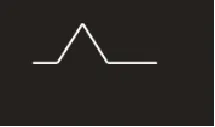一、Definition
Low-Frequency Electrotherapy refers to a method that uses pulsed currents with a frequency of less than 1000Hz to act on the human body for treating diseases. It has effects such as exciting neuromuscular tissues, promoting local blood circulation, relieving pain and reducing inflammation. This therapy is relatively safe, with no obvious electrolysis phenomenon or thermal effect, and has a strong stimulating effect on motor and sensory nerves.
Commonly used low-frequency electrotherapy methods in clinical practice include: Neuromuscular Electrical Stimulation, Transcutaneous Electrical Nerve Stimulation, Functional Electrical Stimulation, Low-Frequency High-Voltage Electrotherapy, etc.
Neuromuscular Electrical Stimulation (NMES)
Transcutaneous Electrical Nerve Stimulation (TENS)
Functional Electrical Stimulation (FES)
Low-Frequency High-Voltage Electrotherapy (HVPC)
三、Parameters
Waveform and Indications
(1) Triangular Wave: Also known as a sawtooth wave, it is characterized by slow rising and falling phases of the waveform. In electrotherapy, triangular waves can help promote blood circulation, reduce edema, and stimulate neuromuscular tissues. It is suitable for electrical stimulation of denervated muscles and smooth muscles.

(2) Square Wave: It is generally used for pain relief, neuromuscular electrical stimulation, and regulation of autonomic nerve function, among other purposes.
(3) Sine Wave: It has a regular waveform with no distortion. It has a relatively strong stimulating effect and is suitable for stimulating both normal and denervated muscles, as well as for treating chronic inflammation。

(4) Exponential Wave: Its waveform is similar to that of a triangular wave, and it is used for electrical stimulation of neuromuscular tissues and smooth muscles.

2. Frequency
It refers to the number of pulses occurring per second, with the unit being Hertz (Hz). In clinical treatment, low-frequency pulsed currents are mostly used for pain relief and stimulating neuromuscular tissues. The frequency selected varies according to different treatment purposes; for example, a frequency of 50-100Hz is commonly used in neuromuscular electrical stimulation.
3. Pulse Width
It refers to the time duration that each pulsed current lasts, usually measured in microseconds or milliseconds. The selection of pulse width depends on the treatment target and tissue response. Narrower pulse widths are more likely to cause nerve stimulation, while wider pulse widths focus more on muscle stimulation.
4. Current Intensity
It is an important parameter describing the magnitude of current, usually measured in milliamperes (mA). An appropriate current intensity should be able to induce effective contraction of the target muscles without causing excessive discomfort to the patient.
5. Electrode Placement
The placement position of electrodes is also one of the key factors affecting the treatment effect. Correct electrode placement can ensure that the current effectively stimulates the target area and avoids unnecessary stimulation of muscles or nerves.
四.Therapeutic Effects
1.Exciting Neuromuscular
TissuesNeuromuscular diseases are common clinical conditions, mainly caused by injuries to the nervous system and skeletal muscle system. They include muscle atrophy, muscle weakness, spasm, and sensory disturbance. Low-frequency electrotherapy stimulates nerve cells to induce muscle excitation, thereby relieving muscle spasm, atrophy, and degeneration. It can also regulate the rhythm of muscle contraction and prevent adhesions between muscle fibers and muscle membranes caused by injury or inflammation.
2.Analgesia
Low-frequency electrotherapy can keep nociceptive sensations in a long-term suppressed state and alter the pain transmission process of the central nervous system to affect the pain control area, thus relieving pain.
3.Anti-Inflammation and Detumescence
Low-frequency electrotherapy can promote local tissue blood circulation, accelerate the absorption of inflammatory metabolites, and stimulate the body to release endorphins. This further achieves pain relief and detumescence, reducing the patient’s suffering.
4.Promoting Blood Circulation
Studies have shown that low-frequency electrotherapy can improve cerebral blood supply insufficiency in patients, reduce blood viscosity, enhance cerebral blood supply, and exert an effect of improving blood circulation.
Neuromuscular DiseasesNeuromuscular diseases are common clinical conditions. Many neurological and orthopedic diseases can cause neuromuscular lesions, including conditions such as muscle atrophy, muscle weakness, spasm, and sensory disturbance.
PainPain is the most common symptom among patients, including chronic low back pain, post-surgical pain, migraine and tension-type headache, osteoarthritis, and lumbar muscle strain.
Spinal Cord InjuryLow-frequency electricity can resist spasm, improve muscle strength, and prevent muscle atrophy by stimulating peripheral nerves. Stimulation therapy for neurogenic bladder urinary retention after spinal cord injury can effectively reduce residual urine volume. Low-frequency electrical stimulation can improve wrist and hand function of the upper limbs after high-level spinal cord injury.
FracturesLow-frequency electrical stimulation has a relaxing effect on different muscle groups and even deep muscle fibers after exercise. It can relieve anterior tibial muscle spasm after strenuous exercise, repair tibial injuries, and prevent stress fractures.
ICU-Acquired Weakness (ICUAW)
It refers to muscle weakness that occurs secondarily without a clear cause in critically ill patients in the ICU. Its main clinical manifestations include difficulty weaning from mechanical ventilation, paresis or quadriplegia, decreased reflexes, and muscle atrophy.
6.Cerebral Palsy (CP)
Treating drooling in children with cerebral palsy by combining rehabilitation nursing with low-frequency electrical stimulation can enhance the children’s swallowing reflex, help them lift the larynx, increase the number of hyoid muscle fibers, and induce explosive muscle contractions, thereby effectively controlling drooling. Using low-frequency electrical stimulation on the head combined with task-oriented training to treat cerebral palsy can effectively improve cerebral circulation and motor function in children with cerebral palsy.
7.Post-Gastrointestinal Surgery
In recent years, scholars have pointed out that the application of low-frequency electrical stimulation in patients with abdominal diseases after surgery can effectively improve surgical outcomes, promote the recovery of gastrointestinal peristalsis function, and reduce the incidence of deep vein thrombosis. This has positive significance for the patient’s treatment and prognosis.
8.Consciousness Promotion
The mechanism of median nerve electrical stimulation in promoting consciousness in comatose patients may be as follows: it increases cerebral blood flow in comatose patients, improves blood supply to the lesion area, reduces the number of necrotic nerves, saves neurons on the verge of losing function, promotes the recovery of nerve function and the self-repair of brain tissue, thus helping the patient regain consciousness as soon as possible.
9.Swallowing Function
Low-frequency electrical stimulation applies physiological electrical stimulation to neuromuscular junctions or motor endplates to depolarize peripheral nerves. This can promote mild muscle contraction, improve local blood circulation, and thereby achieve the goal of enhancing the flexibility and coordination of pharyngeal muscles.
References
He, L. H., Zhang, X. F., Lin, Y., et al. (2017). New progress in low-frequency electrotherapy. World Latest Medicine Information Abstracts (Serial Electronic Journal), 17(93), 44. https://doi.org/10.19613/j.cnki.1671-3141.2017.93.027
Liu, Y. J., Li, H. Y., Guo, M. Y., et al. (2022). Clinical applications of low-frequency electrotherapy. Chinese Medicine Modern Distance Education of China, 20(19), 198-200. https://doi.org/10.3969/j.issn.1672-2779.2022.19.071
Zhang, L., Liu, C., Li, H. M., et al. (2018). Efficacy observation of low-frequency electrical stimulation in the treatment of dysphagia after stroke. Practical Geriatrics, 32(5), 478-480. https://doi.org/10.3969/j.issn.1003-9198.2018.05.022



 简体中文
简体中文
